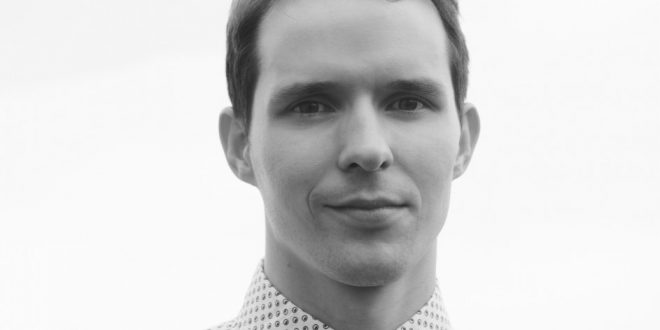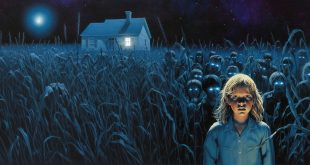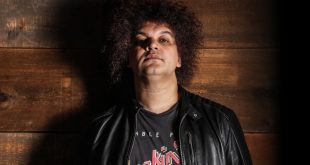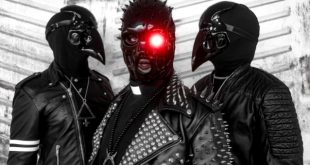As the 2010s nears its remainder, rock music seems to have regained its heavy sensibilities. The indie signing/major distribution practice has become widespread, benefitted not only established acts but younger acts looking to impact the industry long term. Still, that impact has yet to be fully realized, especially in a generation fueled on gadgetry and pop culture craze.
For those seeking an act exuding potential, look no further than Ryan Ewing. A Texas-bred, New York City-based singer-songwriter, Ewing has honed his craft since early childhood. His guitar abilities were developed over 25 years—as early as three years old. When it came to playing other instruments, the transition proved smooth. In fact, listeners have experienced the extent of such talent on his debut album, Mixed Signals. Not only does it feature a one-man ensemble of vocals, guitar, bass and drums; it combines a sound seldom executed well: straight-ahead themes on gritty alternative rock. Whether a reaction to the fickleness of stylistic monotony or a daring attempt to stir the souls of the masses, ultimately, he delivers.
I caught up with Ryan to discuss how this craft developed, as well as thematic breakdown, gear of choice, and above all, showcasing sincere musical merit.
ME: Tell me a bit about your early musical influences, how they shaped the development of your sound.
Ryan: Oh, man, that’s a loaded question to start off with (laughs)!
My dad was a music minister, so I grew up playing in church and what not. That was my early development process I guess you could say. Because he was a minister, we didn’t listen to anything too intense. A lot of golden oldies like the Beatles and Elvis. But then I got into alternative like Nirvana. People have told me the record sounds like Jet, the Script, and Dashboard Confessional. I guess [that influence] is there, so I can’t argue with it, you know? My musical influences vary as much as a radio station, I’m sure.
ME: Since starting on guitar at three years old, had you always had your sights on pursuing a career in music?
Ryan: Well, a career is a tough business to get into, but I knew I’d always be playing music, whatever that meant. Yeah, I started out on guitar when I was younger, but then I moved to drums because it’s more fun to beat things—and people still call it ‘music’ for whatever reason. Then I decided girls were cool, so I moved back to guitar (laughs)! And as soon as I got a band together in Texas, all the girls liked my drummer, ironically. Turns out I was wrong; ladies like drummers. It’s a myth.
ME: Let’s talk about your album Mixed Signals. Were there any particular moments that helped jump-start the writing process?
Ryan: Yeah. The album has songs from over a period of years for sure. There’s some that I wrote while I was in the studio recording, and there’s some that I’d written in high school. I would say what jump-started the process [was] every song [becoming] its own adventure. It was some girl who didn’t make me happy that day, or sometimes I’d wake up with a melody in my head and pair it with lyrics that already had been waiting. Sometimes I’d bang out a song in 30 minutes on the piano. Songs like “Lights Out” were Frankensteins, you know—various things I’d had over the course of a couple years.
For the most part—it’s a cliché thing to say—every song is a different kid. Lyrically, I try to keep them simple enough so that people would relate their own lives, and they’ll have more meaning that way. A lot of it is brutally honest. If you hear something that’s too specific to be false, it’s probably something that happened to me (laughs)!
ME: On this album, you play all the instruments, and as mentioned before, you started on guitar. When it came to learning the other instruments, did you approach them from a self-taught angle?
Ryan: Yeah, I’ve never had a lesson in my life. I’d probably have better music if I did (laughs)! My mom was a church organist, and the piano was always around. She’d tried to teach me but I never had the form. You know, the “1, 2, 3, 4, 5” on the fingers. I was like “I can make that same sound! Who cares where my fingers are?” And that’s a big deal in piano, having your wrists up and what not, so lessons never took off for me.
After that, we had drums. [I was] the only person in my family who played them. My dad and brother played guitar. They were already lying around the house. I guess I didn’t have enough friends to get out of the house (laughs)!
ME: You mentioned having a band back in Texas. When deciding to play all the instruments, had you already come from the band experience and wanted to record everything yourself, and this may have been more efficient?
Ryan: I loved having a band when I was still in Texas. But I moved to New York, was thinking of staying here, and that was kinda it.
As far as going back into the studio and recording some of the songs, I already knew them, so it’s quicker that way than paying a studio musician to sit and learn. They probably would have been better on drums. Actually, there is a guest drummer on one of the songs. Billy Joel’s drummer, Chuck Burgi, jumped on the drums for a song called “Ain’t Lookin’,” which I kind of took offense to at first, I’ll be honest. [The producer said], “Alright, we’ll get a drummer in here,” and I was like, “Oh, no, I’ll play drums,” and they’re like “No. We’re going to bring in Billy Joel’s drummer.” And I really couldn’t have been like “Oh, well I’m…better…than…hi—OK…” They brought him in, and he was way better than I was, so I can’t complain.
ME: So the session musician for “Ain’t Lookin” wasn’t necessarily your choice. Was it up to the producer?
Ryan: Yeah. The producer on that song was Kato Khandwala. That was the only song that was co-written. I wrote all the songs except that one that he co-wrote. He just thought [Chuck] would give me the extra punch, and I was like, “OK, sure.” I was sitting behind the glass while the drummer was on that song. During the song, I’d be like, “Hey, maybe it would work better with this fill,” and Kato’s like, “You’re really going to make a suggestion for Billy Joel’s drummer?” I said, “OK, you’re right (laughs)!” And when you listen to the record, he nails it.
ME: In your bio, you joked around about “Down We Go,” how its ‘corruption of innocence’ theme comes off a bit pretentious. But in a way, doesn’t the song represent a point in our lives when we feel pretentious, acting in ways that aren’t “us”?
Ryan: Yes, absolutely. In my mind, while I was writing that song, I kind of had a mixture of Eve from the Garden of Eden, and Penny Lane from the movie Almost Famous. It’s just embracing the bad side of rock and roll, about corruption and going down the wrong road. Instead of “Oh, no, what have I done,” it’s more like “Hip, hip, hooray, look what I’ve done (laughs)!” There’s definitely a dark side to it.
It wasn’t even supposed to be on the record, though. I was just warming up with that in the studio, and when the engineer came over, he’s like “What is that?” and I said, “Oh, it’s a song I’d written for fun.” I thought it’d stick out like a sore thumb on the record. Sonically, we’d tried to make it work, but it’s kind of like an outlier. I didn’t originally have that in mind, but he was like “You have to put that on the record…”
ME: And it ended up a lot of making a lot of sense in the end, because it showcases your innocence, starting with that sample of you as a baby. Then the rest of the album is essentially your progression into maturity.
Ryan: Wow! He gets it—somebody gets it! I appreciate it. Yeah, that little recording of me as a three-year-old definitely started the record off for sure.
Before I recorded “Down We Go,” I had this concept in my mind that “Lights Out” was going to finish the record because it sounds like a final song. I was going to start it with the song called “Wake Up,” because they kind of act off each other. The last line of “Wake Up” is “Looking for a sign,” and the last line of “Lights Out” is “Show me a sign.” I thought it would be a cool, cyclical thing for the record…like day and night. But once I recorded “Lights Out,” I was like “That can’t wait ‘til the end of the record,” and when I recorded “Down We Go,” I was like, “Well, that’s what’s going to start the record”. So I’m sorry, “Wake Up” got buried (laughs)!
ME: Speaking of “Lights Out”, it now has a music video. What type of stylistic direction were you aiming toward for the video itself?
Ryan: It’s definitely, for better or worse, a one-man show; I did it all myself.
The idea, I don’t know if you’ve seen the teaser, but there’s a voiceover from the movie Walk the Line where [Johnny Cash’s portrayer] goes and auditions for Sun Records. The guy who’s going to record him says, “If you were dying, and you only had one song that summed you up and told God how you felt about your time on Earth, what would it be?” That’s what “Lights Out” was for me. It’s walking in doubt and darkness, and I started thinking what that would look like visually. Then I had this idea. You know how in the Truman Show, you see people walking, and they have a single cloud of rain over them? I had the idea of, not a ray of ‘light’, but a ray of ‘night’ as I pass people. That was the jumping-off point. I wanted to have me in the city walking around New York, so I had to set up the same shot—daytime and nighttime (laughs)! Some of it matched up pretty well, some of it not as great as others, but I was happy with the product once I saw it. It’s just me walking around in darkness, while the rest of the world is doing just fine.
That’s where it started, and then there are clips of me throughout my life. Because the whole dying angle was talked about in Walk the Line, I wanted it to have a “life flashing before my eyes” feel to it. Actually, it’s kind of an homage to Johnny Cash again…the video for his cover of the Nine Inch Nails song, “Hurt”. I’d encourage anybody to watch that, but watch my video first (laughs)! That was kind of like how he’d interspersed footage from his life…and I projected that onto myself next to the performance section.
ME: What “Lights Out” represents to me—it’s kind of like saying things come as fast as they go. You end up spending years investing in someone important, then, when they leave, suddenly you’re just miserable
Ryan: Yeah. It represents a feeling rather than an absolute [event]. I’ve had people tell me, “I know exactly what you’re talking about; someone just died in my life.” It’s not exactly about that, but it’s a backdrop for those moments in life for sure. However it connects to each person, that’s going to mean more to them than anything I can attribute to it. There’s definitely a feeling of absence, so I understand that interpretation.
ME: In relation to the sequence of the album, might the song “Hero” expound on that conflict?
Ryan: Absolutely. There’s a lot about co-dependency in “Hero”—“If you do this, then I have to do this”— and the insecurity that goes along with that. It’s the hope that in the midst of your failure, someone will be patient enough with you. Where it started from was a dream (laughs)! And then it grew into something for me. I have a superhero complex in all the good and bad ways.
ME: I wanted to comment on the album’s sound. It’s crisp and hooky in some areas, but it mostly has this grunge, alternative feel for a lot of the songs. What kind of gear have you used to give it its sound?
Ryan: I was lucky enough to record in a studio in El Paso. They have some of the craziest gear I’ve ever seen. One guitar I played, they used to call it the NBC guitar, and it used to be the guitar they had at Saturday Night Live. You have Clapton and all these different people playing on this guitar, and they didn’t tell me ‘til after I was already using it. I was like “Why are you letting me touch this? This should be in a museum somewhere (laughs)!” Then they had an old guitar that Stevie Ray Vaughn used, a prototype guitar from Billy Gibbons—all these different great guitars.
For me personally, in my own equipment, I have a Gibson 335 which is on the record a little bit. In “Lights Out,” the acoustic is a Taylor 2008 custom that I have, which has like a cocobolo back and sides. We just tried all these different guitars. We had this old Martin, this old Hummingbird, and then it turned out that I really liked the fragile nature of how my personal guitar sounded. Throughout the record, you’ll hear lots of various guitars. I definitely wanted it to have an—I don’t want to say ‘edgy’ feel because it’s not like I’m metal or anything, but a grungier feel than the perfect guitar. Because I am far from perfect…
ME: And you love Nirvana!
Ryan: Exactly (laughs)! There are songs that are a little more pristine than the others. But for the most part, I definitely wanted it to be raw and have a garage sort of feel; instead of these overproduced albums, where they don’t even play guitar. They just push a “guitar button” in GarageBand or Pro Tools or whatever, you know?
ME: Considering how well this album holds up, even down to the sample of you as a child at the very start, it’s like you ultimately wanted to give it a sense of longevity.
Ryan: Well, I hope it holds up. I appreciate you saying that. I would like to believe I’m current. Like I said, I was shaped by oldies, so hopefully it’s not ‘so’ current or ‘so’ dated. It’s something you can turn back on in a few years and still be like, “Oh, that’s a good melody!”, and it won’t even matter how it was recorded. I hope when my kids hear it someday, they won’t be too embarrassed (laughs)!
ME: Lastly, anything you’d like to say to your fans?
Ryan: I’d say that this record and this video were a labor of love for sure. “Lights Out,” of all the songs on the record, is definitely one of my most brutally honest and personal. That’s why it starts out with the quiet acoustic because I wanted it to feel like, “Hey, you’re in the room with me,” and then it goes into the stratosphere with a big orchestra and a thousand vocals.
I don’t know. It’s weird to think about what to say to the fans. I don’t even think they exist (laughs)! But I’d say I hope this works for them. Like I said about “Lights Out,” I want it to mean something to somebody. The video that I put all my blood sweat and tears into—it was all me, all over the city. I hope when people watch it, it makes them think about something. It’s not just some stupid video like “Down We Go”—which is a fun video! But, you know, it’s just a single shot of me dancing, doing the Macarena. This is the exact opposite (laughs)! It’s very, very different, so I hope the people who did enjoy “Down We Go” will appreciate this on a different level. And maybe the people who didn’t like “Down We Go” will be like “Oh, this is a little more up my alley. He’s not just dancing around like an idiot; he’s actually trying to say something.” I hope people give the album a listen, give the video a watch, and like it or not, here I am (laughs)!
Ryan Ewing Socials:
Facebook|Twitter|Official Website
Buy Mixed Signals:
“Lights Out” Official Music Video:
 Music Existence Because of Music, We Exist
Music Existence Because of Music, We Exist




